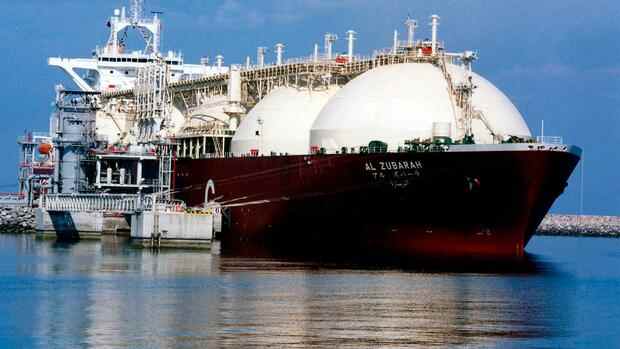Traders are waiting for the right second point to unload the liquefied gas in Europe.
(Photo: AP)
Brussels, Berlin According to experts, the large number of tankers with liquefied natural gas (LNG) on board lying off the European coast shows that the gas market in Europe is not yet functioning. At the moment, 34 ships carrying liquefied natural gas (LNG) are anchored at sea without calling at a port. The number of transporters could increase further: According to the analysis company Vortexa on Thursday, 30 more ships are on their way across the Atlantic to Europe.
Europe and especially Germany actually need the gas. But currently 95 percent of the gas storage facilities are full. Where there is still space, gas hardly ever arrives due to a lack of infrastructure.
There is a lack of terminals to land the liquid gas; there is a lack of regasification plants that process the liquefied gas from the ships into gas, and there are no pipelines with which the gas could be brought to the storage facilities and to the customers. “The basic problem is a lack of integration of the European energy markets,” says the CDU energy politician Christian Ehler. “We need to invest more.”
The bottlenecks in the infrastructure affect the prices at the LNG traders: On the gas exchanges, the price briefly slipped into the red again this week. Because the buyers simply no longer have the opportunity to take the gas from the sellers.
Top jobs of the day
Find the best jobs now and
be notified by email.
This is particularly evident in Spain: although the country has many terminals, it is hardly connected to the rest of Europe by pipelines. That’s why it’s not worth dumping gas there. Germany, France and Spain recently agreed to build a new connection. It will be a few more years before it can be used.
Additional tanks at the terminals could help
The storage operators reject the obvious idea of expanding gas storage facilities in Europe: “Gas storage capacities in Germany have been declining since 2014. Years ago, politicians took positive note of this development with reference to supposed overcapacities,” said Sebastian Bleschke, Managing Director of the Energy Storage Initiative (INES). There is therefore a “healthy skepticism” in the industry when politicians call for further investments.
>> Read here: LNG tankers stopped – gas traders are waiting for a better gas price
The energy expert Walter Bolz also considers the capacities to be sufficient in the long term: “Europe consumes around 500 billion cubic meters of gas per year. Our storage facilities hold a good 100 billion cubic meters,” he says. “That’s actually a sufficient ratio, as long as the EU countries help each other out in the event of shortages.” According to Boltz, it would be helpful to build additional tanks at the LNG terminals. The gas is stored in liquid form in these tanks before it is regasified and fed into pipelines.
Experts consider it unlikely that the LNG traffic jam will repeat itself in the coming years. The problems will be completely different, said EU Commission President Ursula von der Leyen on Wednesday. She spoke of a “considerable risk” that Europe would lack around 30 billion cubic meters of liquid gas in the coming year to bring the storage tanks back to the current levels.
That depends on factors on the world market, such as China’s needs. The consequences could be all the more dramatic if the gas does not find its way to Europe as soon as it is available on the market due to a lack of infrastructure.
More: Liquid gas tankers are waiting in front of Europe’s terminals for higher prices: that helps gas customers – a comment
